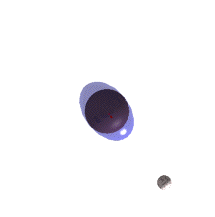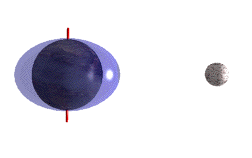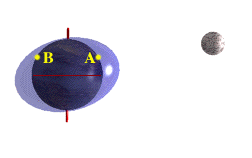
| Home |
| Glossary |
| Lobstering |
| Some Facts |
| Handling Gear |
| Wildlife |
| Tools |
| A Day at Sea |
| The Boat |
| Lobsters |
| Facts |
| Molting |
| Eggers |
| Oversized |
| The Sea |
| About Tides |
| Misc |
| Credits |
| Site Policy |
| The Author |
| Today's Hi/Lo Tides |
11/19/25
04:07 1.125 L
10:21 9.202 H
16:43 0.187 L
22:58 8.157 H
Station: Fort Point, NH
Station-local tide times. Height in Feet (MLLW).
Data are predictions supplied by the NOAA Tidal Predictions
Web Service.
Last updated:
11/19/25 05:59 UTC |
The System in Motion
Twice each month, the earth, moon, and sun line up, or come into conjunction, once when the moon is between the earth and sun (new moon), and once when the earth is between the moon and sun (full moon). When the earth, moon, and sun are in conjunction their forces align. The result is a greater distortion of the water envelope. This makes for higher than average tidal ranges. These are called 'spring tides'. Spring tides, then, will occur twice each month with the new and full moon (and has nothing to do with the season of the year, as the name infers).
When the moon is in quadrature, its pull is perpendicular to that of the sun. The two forces are in conflict and this tends to reduce the amount of distortion, making for lower than average tidal differences. These tides are called 'neap tides'.
Watch what happens to the water envelope of the model in the animation below as the three bodies come into and move out of conjunction.

Looking down from a pole you can get a better view of how the moon and sun act together to distort the envelope of water around our simplified planet model. The sun is to the lower right and outside of the frame of view.
The moon follows a complex orbit which causes it to cross the equator periodically. As it does so, it effects the height and periodicity of tides in various places around the world.

If we take a snapshot every time the moon is between the earth and sun and string those pictures together it might look somthing like this.
The illustration below shows what the water envelope looks like when the moon is over a hemishpere. Lets say points A and B represent the location of Kittery, Maine at noon and midnight of the same day. In a 24 hour period, Kittery would experience two tides of unequal tidal height. Moreover, the further north you go from Kittery, the more you would expect to have only a single tide in a 24 hour period. What changes would you expect when the moon is over the equator?

The effect of the moon's migration across the equator on a point in north latitude.
Yet another variable involved is the shapes of the orbits themselves. The moon's orbit with the earth is eliptical in shape which means that there are times when the moon is closer to the earth than others. The closer it is, the greater the effect it has on the earth and its tides. The same is true of the earth's orbit around the sun.
Given all these factors (and more I haven't mentioned...or know of), predictions of tidal ranges tend to repeat themselves every 19 years or so. Clearly there is much more going on than what is covered here.